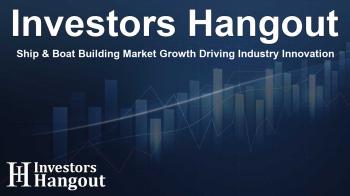Ship & Boat Building Market Growth Driving Industry Innovation

Exploring the Ship & Boat Building Market's Future
The ship and boat building market is currently atop a robust growth trajectory. According to a recent market analysis, the sector is expected to reach a valuation of US$ 527.61 billion by 2034, up from US$ 183.69 billion in 2024, reflecting a significant compound annual growth rate (CAGR) of 11.1%.
Factors Contributing to Market Expansion
This remarkable growth is driven by escalating demands across various maritime sectors for new vessel construction. As global trade rebounds post-pandemic, there’s an evident spike in new orders for container ships. Additionally, the ongoing transformation in the energy sector, particularly linked to offshore wind farms and liquefied natural gas (LNG) transportation, fuels demand for specialized vessels.
Impact of Tourism and Defense Spending
Cruise lines are revitalizing their fleets, reflecting a new wave of tourism recovery. With the influx of travelers, the commissioning of new ships is set to rise. On a different note, naval defense spending has increased globally, leading to additional military vessel contracts, showcasing the market's diverse demands.
Embracing Sustainability in Shipbuilding
The fishing industry's modernization also plays a pivotal role, as it aims to meet sustainability requirements and enhance efficiency. This comprehensive market evolution not only supports substantial job creation but also encourages technological innovations specifically in the realms of automation and sustainability.
Regional Insights and Opportunities
Shipyards in Asia, particularly in countries like China, South Korea, and Japan, are seeing their order books filled up through 2026. European shipbuilders are also experiencing a surge in demand, particularly for luxury yachts and specialized vessels. This industry expansion distinctly highlights the fundamental role maritime transport plays in global business.
Innovation at the Forefront
Among the leading players driving innovation in the ship and boat building market are major companies such as Mitsubishi Heavy Industries Ltd, Hyundai Heavy Industries Co. Ltd, and China State Shipbuilding Corporation. These organizations are not only reshaping ship designs but also enhancing operational capabilities through advanced technologies.
Technological Advancements Reshaping the Industry
Modern shipbuilding incorporates autonomous navigation systems boosted by artificial intelligence and advanced sensors that improve safety while cutting down on crew requirements. Smart cargo management systems utilizing IoT sensors provide real-time updates on container conditions, significantly optimizing logistics.
Enhancing Passenger Experience
For passenger vessels, the introduction of digital twins allows for virtual replicas of ships, enabling predictive maintenance and operational optimization. New propulsion systems, such as hybrid models, are progressively reducing the environmental footprint while simultaneously lowering operational costs.
Industry Highlights and Developments
- Recent orders include several newcastlemax bulk ships commissioned by China Merchants Energy Shipping from New Times Shipbuilding, slated for completion in 2028.
- Damen Shipyards has secured a contract with the Portland Harbour Authority to supply the agile ASD Tug 2111, showcasing innovation in design and function.
As this industry continues to evolve, manufacturers are introducing a plethora of facilities and features that rapidly advance the maritime business landscape. Facilities such as improved connectivity through satellite internet, smart ballast water systems, and advanced stabilization features are enhancing both logistic efficiency and passenger comfort.
Frequently Asked Questions
What is the projected value of the ship & boat building market?
The ship & boat building market is forecasted to reach US$ 527.61 billion by the end of 2034.
What are some driving forces behind the market growth?
Key drivers include increasing orders for container ships, rising demand for specialized energy transport vessels, and revitalization of cruise lines.
Which regions are seeing the most growth in shipbuilding?
Asia, particularly China, South Korea, and Japan, along with parts of Europe, are reporting significant expansions in shipbuilding activity.
What innovations are impacting the industry?
Innovations such as autonomous navigation, IoT-enabled cargo systems, and hybrid propulsion are leading the charge in enhancing efficiency and sustainability.
Who are the major players in the shipbuilding sector?
Major players include Mitsubishi Heavy Industries Ltd, Hyundai Heavy Industries Co. Ltd, and China State Shipbuilding Corporation, among others.
About Investors Hangout
Investors Hangout is a leading online stock forum for financial discussion and learning, offering a wide range of free tools and resources. It draws in traders of all levels, who exchange market knowledge, investigate trading tactics, and keep an eye on industry developments in real time. Featuring financial articles, stock message boards, quotes, charts, company profiles, and live news updates. Through cooperative learning and a wealth of informational resources, it helps users from novices creating their first portfolios to experts honing their techniques. Join Investors Hangout today: https://investorshangout.com/
Disclaimer: The content of this article is solely for general informational purposes only; it does not represent legal, financial, or investment advice. Investors Hangout does not offer financial advice; the author is not a licensed financial advisor. Consult a qualified advisor before making any financial or investment decisions based on this article. The author's interpretation of publicly available data shapes the opinions presented here; as a result, they should not be taken as advice to purchase, sell, or hold any securities mentioned or any other investments. The author does not guarantee the accuracy, completeness, or timeliness of any material, providing it "as is." Information and market conditions may change; past performance is not indicative of future outcomes. If any of the material offered here is inaccurate, please contact us for corrections.
